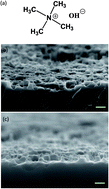High efficiency conjugated polymer/Si hybrid solar cells with tetramethylammonium hydroxide treatment†
Abstract
Conjugated polymer/Si hybrid solar cells are fabricated based on a Si nanowire array (SiNW) substrate prepared by metal-assisted electroless etching. With a facile method involving immersing the SiNW substrate in anisotropic tetramethylammonium hydroxide (TMAH) solution just for few minutes, the power conversation efficiency (PCE) of the hybrid solar cell can be 12.36%, which is 69.5% higher than that of pristine one. The efficiency improvement mechanism is discussed and analyzed in detail, and all the results demonstrate that with the TMAH treatment, the density of the SiNWs is reduced, and the electrochemical contact between the PEDOT:PSS and SiNWs as well as the rear contact is obviously improved, all of which significantly suppress the charge recombination in the hybrid solar cells. Our major investigation emphasizes the importance of the TMAH treatment to nanostructured Si and renders a promising approach to obtain low-cost and high performance conjugated polymer/Si hybrid solar cells.


 Please wait while we load your content...
Please wait while we load your content...